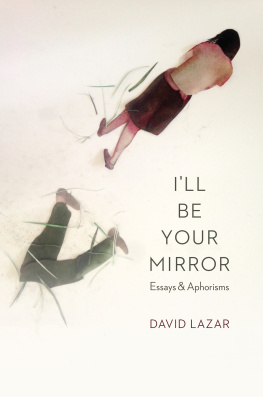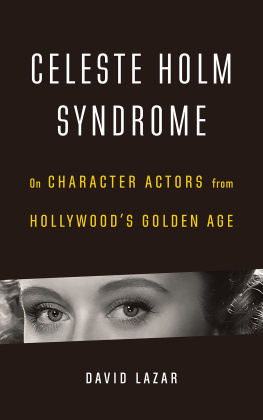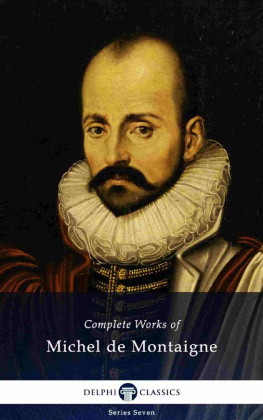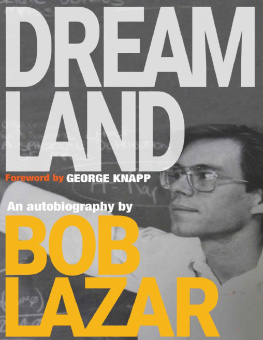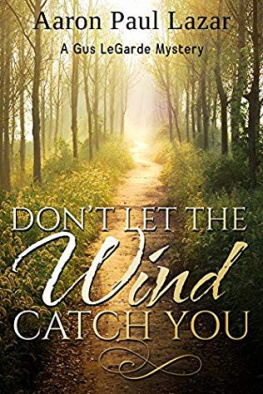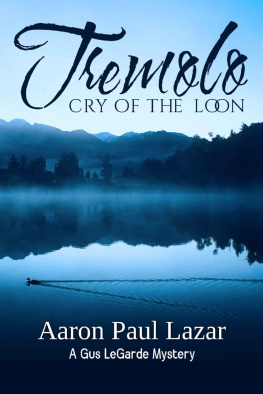David Lazar - After Montaigne
Here you can read online David Lazar - After Montaigne full text of the book (entire story) in english for free. Download pdf and epub, get meaning, cover and reviews about this ebook. year: 2015, publisher: Lightning Source Inc. (Tier 3), genre: Art. Description of the work, (preface) as well as reviews are available. Best literature library LitArk.com created for fans of good reading and offers a wide selection of genres:
Romance novel
Science fiction
Adventure
Detective
Science
History
Home and family
Prose
Art
Politics
Computer
Non-fiction
Religion
Business
Children
Humor
Choose a favorite category and find really read worthwhile books. Enjoy immersion in the world of imagination, feel the emotions of the characters or learn something new for yourself, make an fascinating discovery.

- Book:After Montaigne
- Author:
- Publisher:Lightning Source Inc. (Tier 3)
- Genre:
- Year:2015
- Rating:4 / 5
- Favourites:Add to favourites
- Your mark:
- 80
- 1
- 2
- 3
- 4
- 5
After Montaigne: summary, description and annotation
We offer to read an annotation, description, summary or preface (depends on what the author of the book "After Montaigne" wrote himself). If you haven't found the necessary information about the book — write in the comments, we will try to find it.
After Montaigne — read online for free the complete book (whole text) full work
Below is the text of the book, divided by pages. System saving the place of the last page read, allows you to conveniently read the book "After Montaigne" online for free, without having to search again every time where you left off. Put a bookmark, and you can go to the page where you finished reading at any time.
Font size:
Interval:
Bookmark:
AFTER MONTAIGNE
Contemporary Essayists Cover the Essays

EDITED BY DAVID LAZAR AND PATRICK MADDEN

2015 by the University of Georgia Press
Athens, Georgia 30602
www.ugapress.org
All rights reserved
Designed by Melissa Bugbee Buchanan
Set in Adobe Garamond Pro and Cronos Pro
Printed and bound by Thomson-Shore
The paper in this book meets the guidelines for permanence and durability of the Committee on Production Guidelines for Book Longevity of the Council on Library Resources.
Most University of Georgia Press titles are available from popular e-book vendors.
Printed in the United States of America
19 18 17 16 15 c 5 4 3 2 1
Library of Congress Cataloging-in-Publication Data
After Montaigne : contemporary essayists cover the essays / edited by David Lazar and Patrick Madden.
pages cm
Includes bibliographical references and index.
ISBN 978-0-8203-4815-5 (hardcover : alk. paper) ISBN 978-0-8203-4817-9 (ebook)
1. American essays21st century. 2. Montaigne, Michel de, 15331592Influence. I. Lazar, David, 1957 editor. II. Madden, Patrick, 1971 editor. III. Montaigne, Michel de, 15331592. Essais.
PS 689.a37 2015
814.6dc23
2014045430
British Library Cataloging-in-Publication Data available
To Seigneur de Montaigne,
our inspiration,
and tienne de La Botie,
his inspiration
Bees cull their several sweets from this flower and that blossom, here and there where they find them, but themselves afterwards make the honey... so the several fragments [one] borrows from others, he will transform and shuffle together to compile a work that shall be absolutely his own.
I never speak of others, but that I may the more speak of myself.... these are my humors and opinions; I offer them as what I believe, not what is to be believed.
MONTAIGNE, OF THE EDUCATION OF CHILDREN
DAVID LAZAR
E. J. LEVY
BRIAN DOYLE
LIA PURPURA
MARY CAPPELLO
WAYNE KOESTENBAUM
LINA M. FERREIRA C.-V.
DANIELLE CADENA DEULEN
NICOLE WALKER
BRET LOTT
VIVIAN GORNICK
STEVEN CHURCH
KRISTEN RADTKE
ROBIN HEMLEY
BARRIE JEAN BORICH
DESIRAE MATHERLY
JOS ORDUA
JUDITH ORTIZ COFER
SHANNON LAKANEN
ROBERT ATWAN
JERALD WALKER
AMY LEE SCOTT
CHRIS ARTHUR
MARCIA ALDRICH
PATRICK MADDEN
ELENA PASSARELLO
MAGGIE NELSON
PHILLIP LOPATE
The editors heartily thank our essayists, for their engagement with the reimagi-nation of Montaigne we asked of them. We also thank our students and teachers (its nice to see the cart before the horse sometimes).
Much gratitude to Sydney Dupre and Walter Biggins at the University of Georgia Press for their extraordinary support.
Patrick Madden would like to thank his family, near and far, young and old. They are participants in and witnesses to his unwritten essays.
David Lazar would like to thank his lucky stars, since its about time. Friends and family gathered under them, and were kind.
Steven Churchs Of Idleness was first published as On Loitering in Rumpus, May 16, 2013, therumpus.net/2013/05/on-loitering.
Lia Purpuras Of Prayers originally appeared in Ecotone 8, no. 1 (Fall 2012).
AFTER MONTAIGNE
Montaigne... to whom, down even to our own day, even in point of subject-matter, every essayist has been more or less indebted... /... is an immense treasure-house of observation, anticipating all the discoveries of succeeding essayists. / He has left little for his successors to achieve in the way of just and original speculation on human life. Nearly all the thinking of the [succeeding] centuries, of that kind... is to be found in Montaignes Essays.
ALEXANDER SMITH / CHARLES LAMB / WILLIAM HAZLITT
What do the Beatles Twist and Shout, Aretha Franklins Respect, Elvis Presleys Blue Suede Shoes, Jimi Hendrixs All Along the Watchtower, and Ike and Tina Turners Proud Mary have in common? Theyre all cover songs, songs originally recorded by other artists (the Isley Brothers, Otis Redding, Carl Perkins, Bob Dylan, Creedence Clearwater Revival, in these cases), then borrowed, modified, flavored in new ways by new musicians. Covering is a long and proud tradition in music, especially popular music in the last half century, and if you think about it, before recorded music, most performances were covers (of a sort). Recording a cover is a way of paying homage to a respected forebear while simultaneously asserting newness and individuality. In some cases, a cover song achieves greater popularity than the original. In some cases, people dont even realize the cover is a cover.
For 350 years, almost every essayist paid homage to the creator of the essay form: Michel de Montaigne. While there were precursors of the essaycognates and close influencesBob Wills and the Texas Playboys (great stuff!) are not Chuck Berry. But even Chuck Berry didnt create rock n roll. Montaigne stands virtually alone as having introduced a new form of writing: the 107 essays contained in books I, II, and III of the Essais, published in 1580, 1588, and 1595.
Essayists and aficionados of the essay will please excuse a few reiterations of the basics: Montaigne, who lived from 1533 to 1592 and was raised by a genteel and progressive father, led a life that was politically engaged in troubled times. He witnessed plague, wars of religion between Catholics and Huguenots, and personal tragedies: the deaths of his beloved friend tienne de La Botie, his younger brother (from a tennis ball that hit him in the head!), and all but one of his children in infancy. But Montaigne stayed engaged with life, with ideas, and, most important for our considerations, with the creation of a form that he called the essai, coining the term from the verb essayer, to try or attempt, which started and sustained an innovative, playful, experimental edge to prose.
Those doing the math at home will have noticed that 350 years doesnt quite get us to the present. This is our observation, one that sparked the creation of this book: that what was once so blatantly obviousMontaignes greatness and influencehas become less acknowledged. His formal inventiveness, disarming intimacy, and rhetorical complexity, which were once the essential tracks for anyone listening to the essay or listening to themselves trying to understand what an essay might be, are often simply ignored or are considered quaintly traditional. Some newcomers to the essay seem to have trouble hearing Montaignes orchestral brilliance just because he is old. Its like being unable to keep hearing how radical Louis Armstrong is. New students in MFA and PhD programs calling themselves essayists arrive (and sometimes even leave) without having read a single essay by the writer to whom they are inextricably indebted. Their curiosity about the tradition of the essay doesnt seem to reach very far back in the essays history. This is a great shame, a disgrace. So much thats vital about the essay seems uncannily present, explicitly or in utero, in Montaigne.
This anthology aims to modestly correct that trend and reassert Montaignes centrality. We asked more than two dozen of the most exciting essayists writing today to give us their take on a Montaignean subject. Like an album of cover songs paying homage to an influential band or composer, these essays attempt to reenvision Montaignes topics through a contemporary sensibility. Each one uses Montaignes original title (or an inspired variation) and begins with an epigraph from Montaigne, ending with a coda explaining the process through which the essayist translated, transfigured, reimagined, or rethought some of the essential ideas, figures, and motifs in Montaignes original.
Next pageFont size:
Interval:
Bookmark:
Similar books «After Montaigne»
Look at similar books to After Montaigne. We have selected literature similar in name and meaning in the hope of providing readers with more options to find new, interesting, not yet read works.
Discussion, reviews of the book After Montaigne and just readers' own opinions. Leave your comments, write what you think about the work, its meaning or the main characters. Specify what exactly you liked and what you didn't like, and why you think so.

